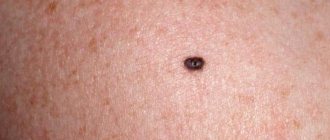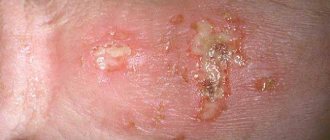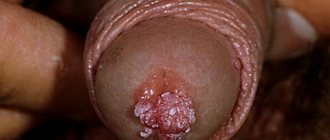18.01.2019
Introduction from D.S.: the article may seem a bit dry and boring if your work is not related to dermato-oncology. If this is the case, you can only read my explanations, they will be highlighted in gray. I have also highlighted the most important passages in the original text bold italics . Reading these fragments will be enough to form an opinion about the problem of spots on the genitals.
Alexandra M. Haugh, BA, Emily A. Merkel, BA, Bin Zhang, MS, Jeffrey A. Bubley, BA, Anna Elisa Verzi, MD, Christina Y. Lee, BA, and Pedram Gerami, MD
A clinical, histologic, and follow-up study of genital melanosis in men and women
Description of the problem: Clinically, genital melanosis is difficult to distinguish from melanoma. There is insufficient data on the risk of developing melanoma due to genital melanosis.
Objectives of the study: To analyze and characterize lesions that are clinically defined as genital melanosis, and to assess the risks of developing genital melanoma and melanoma at other body sites using a retrospective cohort study.
Methods: observation of 41 patients with genital melanosis, as well as analysis of the results of histological examination of the formations.
Results: Genital melanosis may be difficult to distinguish clinically from genital melanoma. However, the first condition develops at an earlier age than the second. Most lesions identified as genital melanosis stabilize or regress. 5 of 41 patients had a history of melanoma. Only one of them had genital melanoma. Most of the formations were characterized by melanocytes with suprabasal migration.
Limitations: The studies were conducted on a small number of patients for a limited time.
Conclusion: patients with genital melanosis, especially with atypia according to histological examination, require regular monitoring. This is necessary to detect the development of melanoma in time.
Genital melanosis is rare. This condition is observed in 0.01% of patients who consult a dermatologist [1, 2]. There is insufficient scientific data on this issue. Manifestations of genital melanosis are atypical. They are characterized by large areas of mucosal pigmentation that are clinically indistinguishable from melanoma. Almost nothing is known about the role of genital melanosis in the development of genital melanoma and melanoma of other skin and mucous membranes.
During the study, researchers observed 41 patients with genital melanosis. They also studied the results of histological studies. Finally, the researchers analyzed the history and incidence of melanoma in patients with genital melanosis. The data obtained should help clinicians choose the right diagnostic and treatment tactics when treating patients with genital melanosis.
Methods
The study involved 41 patients with genital melanosis. The criterion for participation was the presence of a mass larger than 1 cm or multiple associated lesions whose total size exceeded 1 cm.
The patients were divided into two groups according to the size of the formation. The first included participants with formations larger than 1.5 cm, the second included participants with formations less than 1.5 cm.
Biopsies were performed in 35 of the 41 patients. During the histological examination, pathologists assessed, among other things, the following data:
- The number of melanocytes per square millimeter of the epidermis.
- Presence of nuclear atypia.
- Location of melanocytes in the epidermis.
Five patients were biopsied multiple times. Samples with the highest number of melanocytes per square millimeter of epidermis were used for overall statistical analysis.
What do blue spots on the head of the penis mean?
In most cases, blue spots are of vascular origin.
They are clotted blood.
There are several possibilities why this could happen:
- injury to the penis - a normal bruise has appeared, which will go away on its own after some time
- bleeding without injury - may indicate problems with blood clotting or increased fragility of blood vessels
- vasculitis – inflammation of blood vessels
- thrombophlebitis - inflammation of a vein and the appearance of a blood clot inside it
Less commonly, the cause is a skin lesion or rash.
This may be a nevus and some dermatological diseases.
results
Detailed clinical examination results were available for 38 of the 41 study participants. In 17 cases, the genital lesions were irregular in shape and color. In 22 cases, the lesions had at least two colors, including several shades of brown and black, zones of white or gray regression, and mixed zones of hyper- and hypopigmentation.
The size of 12 lesions exceeded 1.5 cm. 22 patients had multiple lesions, and 19 patients had only one.
The researchers found no significant correlations between clinical manifestations and histological results.
The researchers also checked for a history of human papillomavirus (HPV) infections and inflammatory dermatoses. HPV and inflammatory dermatoses are considered risk factors for the development of genital melanosis. During the analysis, no connection was found between HPV infection and inflammatory dermatoses with clinical or histological manifestations of genital melanosis.
The history of melanoma in close relatives and the person himself was analyzed in 32 and 34 patients, respectively. 7 out of 32 had melanoma in relatives, and 5 out of 34 had melanoma in their personal medical history. Only one patient was diagnosed with genital melanosis and genital melanoma simultaneously. Those. on the genitals of one person in different places (!) both genital melanosis and melanoma were present (approx. D.S.)
No correlation was found between family history of melanoma and clinical manifestations of genital melanosis.
In patients with melanoma, a tendency towards an increase in the number of suprabasally located melanocytes was revealed. The average number of melanocytes per square millimeter was 53.6. In patients without melanoma, this figure was 35.5.
Of the three patients with nuclear atypia in melanocytes, two had a history of melanoma.
Follow-up history is known for 30 of the 41 patients. None of the 30 participants developed genital melanoma. In one patient, genital melanosis developed 10 years after identification and successful removal of genital melanoma.
Detailed descriptions of clinical examination findings are available for 23 patients. Nine of the 23 study participants had unchanged genital lesions over 33 months. Ten of the 23 patients had no evidence of residual lesions 56 months after diagnosis of genital melanosis. Only 2 out of 23 people had relapses after excision of the formations. No correlation was found between the recurrence rate and any histological or clinical features.
Taking medications
The appearance of red dots and spots on the head may be associated with constant use of antibiotics (especially tetracycline, sulfonamides), salicylates, Phenacetin, Co-trimoxazole and some other drugs.
The rashes have a clearly defined round or oval shape and a bright red color; a bubble of liquid may form in the center of the spot.
In most cases, discontinuation of the drug leads to gradual resolution of the rash. Sometimes the prescription of glucocorticoid ointments is required. Healing is accompanied by the formation of pigment spots.
The discussion of the results
During the study, doctors studied data from clinical observation and histological analysis of 41 patients with genital melanosis. In 22 patients, the formations had several colors; in 11 patients they were more than 1.5 cm.
Researchers considered the average age of onset of this condition to be one of the clinical signs of benign genital melanosis. Among the study participants, it was 41 years. Genital melanoma develops on average in the sixth decade of life.
The researchers concluded that it is necessary to avoid unnecessary surgical intervention for genital melanosis. Clinicians consider it necessary to excise and send for histological examination all formations that seem suspicious to them. In the case of genital melanosis, this approach is not necessary. Most of the lesions examined during the study with clinical atypia, such as multiple colors and larger than 1.5 cm in size, were found to be benign.
Excisional biopsy in the genital area not only causes discomfort for the patient. The operation can harm sexual health and disrupt urinary function. The cosmetic result of the operation may be unfavorable.
Researchers have found that in most cases of genital melanosis, it is sufficient to actively monitor patients. Only one of the 41 study participants had both genital melanosis and genital melanoma. In this patient, genital melanosis was discovered almost 11 years after the diagnosis of vulvar melanoma. The formation was excised, and according to the results of histological examination it was recognized as benign.
During 30.5 months of follow-up, none of the study participants developed genital melanoma due to genital melanosis. In 19 patients who came for examination, the formations stabilized, decreased or disappeared. One patient was diagnosed with recurrence of genital melanosis after excision of the lesion.
Based on these data, the researchers concluded that the risk of genital melanosis transforming into melanoma is so small that it is difficult to measure.
The incidence of genital melanosis in the population is unknown. According to studies [1, 2], this condition occurs in 0.011% of patients who come to see a dermatologist. The incidence of genital melanoma is 0.19 cases per 1 million men and 1.8 cases per 1 million women. [4]
The study found that 15% of the experiment participants had a history of melanoma. In only one out of five cases the tumor was found in the genital area. The average age of patients with melanoma was 39 years.
Scientists have confirmed an increased incidence of genital melanosis in patients with a history of melanoma. Such patients have a suprabasal distribution of melanocytes, as well as an increased number of melanocytes in the epidermis.
Genital melanosis with clinical signs of atypia is recognized as an indication for active monitoring of patients, including examination of the whole body with a dermatoscope. However, according to the study, genital melanosis cannot be considered a precursor to genital melanoma. Therefore, in most cases, in patients with genital melanosis, radical surgery with excision of formations is not indicated.
How to treat?
Prevention of the disease is the best way to avoid serious consequences. And a significant role in this belongs to compliance with the rules of personal hygiene.
If you notice the first signs, it is important to immediately consult a doctor who will prescribe the correct treatment. A paid urologist will conduct an examination and prescribe appropriate treatment.
The private medical clinic “Doctor Anna” has all the necessary equipment to diagnose the disease and invites you to undergo an examination. Experienced specialists will diagnose, identify the causes of the disease and select an effective course of therapy.
SUMMARY FROM D.S.:
This study shows that age spots on the genitals are, in the vast majority of cases, NOT DANGEROUS. However, researchers note a possible increased risk of developing skin melanoma (not just the genitals, but also other areas) in people with genital melanosis. This means that if you have similar pigment spots, they must be examined annually with a dermatoscope by an oncologist or dermatologist, just like ALL other pigmented skin formations.
Causes of redness and itching of the head in men
Symptoms of inflammation are caused by:
- Fungal infection - occurs in 20% of cases, the spots are characterized by the presence of a specific white lumpy coating, the smell of sauerkraut or fish.
- Sexual infections - chlamydia, ureaplasma, gonococci and other microbes can cause plaque on the head in men, redness and swelling of the tissues; Discharge from the urethra does not always occur.
- Dysbacteriosis is a violation of the bacterial microflora, when bacteria that are usually not characteristic of it, for example from the intestines, settle on the scalp.
- Allergies to shower gel, lubricants, synthetic underwear - can only appear on the scalp, without affecting other parts of the body; characterized by red pimples and peeling, the spots are very itchy.
Redness, swelling and other manifestations of inflammation intensify after sexual intercourse and ejaculation.
To identify fungi or bacteria that cause redness of the glans in men, 2 tests are done: PCR and culture of smears from the urethra and the skin of the penis.
When the presence of microbes is not detected, basic immunological tests are performed. If they are rejected, a consultation with an allergist is prescribed.
Probability of infection
Women and men have an approximately equal risk of becoming infected without knowing it at all, since the peak of infection occurs in adolescence and older, when alertness to herpesvirus, papillomavirus, and HIV infection decreases.
At the same time, more attention is paid to sexually transmitted diseases, which, however, are also characterized by high dynamics of infection.
The number of sexual partners remains an important point, since today more than 190 types of HPV have already been described and every year there are more strains of the virus. The International Agency for Research on Cancer identifies 12 strains that are associated with the development of cancer of various locations:
- cervix;
- vulva;
- vagina;
- anal canal;
- penis.
By choosing the smallest number of sexual partners, the risk of becoming infected with HPV, including its oncogenic strains, is significantly reduced.
It is necessary to remember about personal hygiene, as well as the existence of vaccination, which reduces the risk of developing HPV by 95%. It is more effective to vaccinate before the age of 14 years, but up to 25 years of age is also possible. The vaccine provides the greatest protection if it was administered before the onset of sexual activity.
Treatment
Treatment depends on the cause. To achieve stable remission in herpes, antiviral treatment is needed, as well as measures aimed at eliminating symptoms. Syphilis, chancroid, balanitis are treated with antibiotics. For cancer – surgery, chemotherapy, radiation. Injury may also require treatment by a surgeon.
Come to our clinic with any alarming symptoms. “Andrologist03” is a specialized diagnostic and treatment institution that has everything necessary for the treatment of male diseases. Registration and information - by phone.











